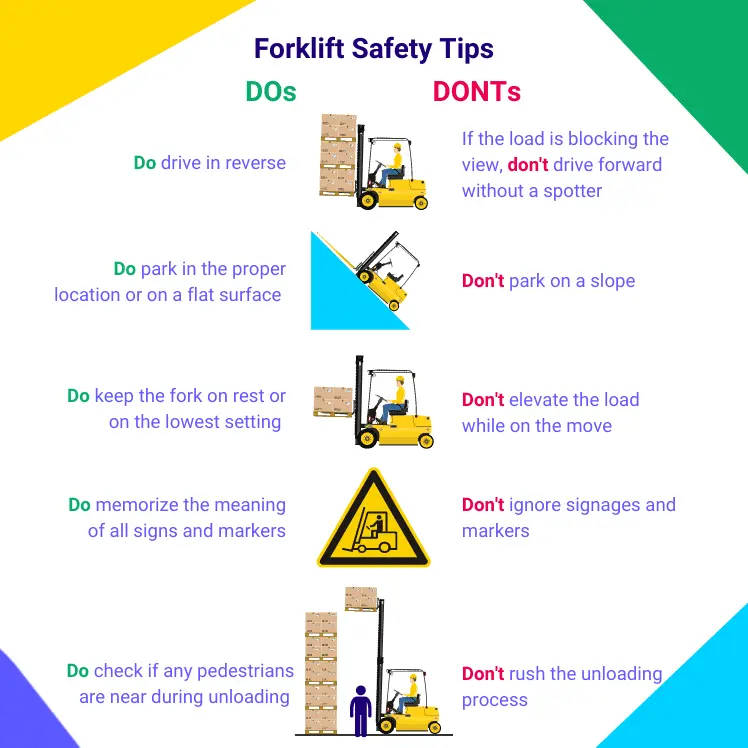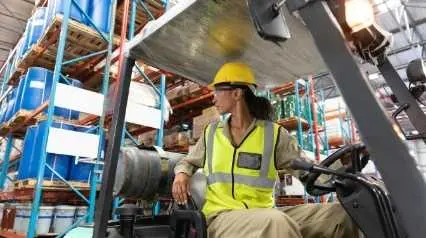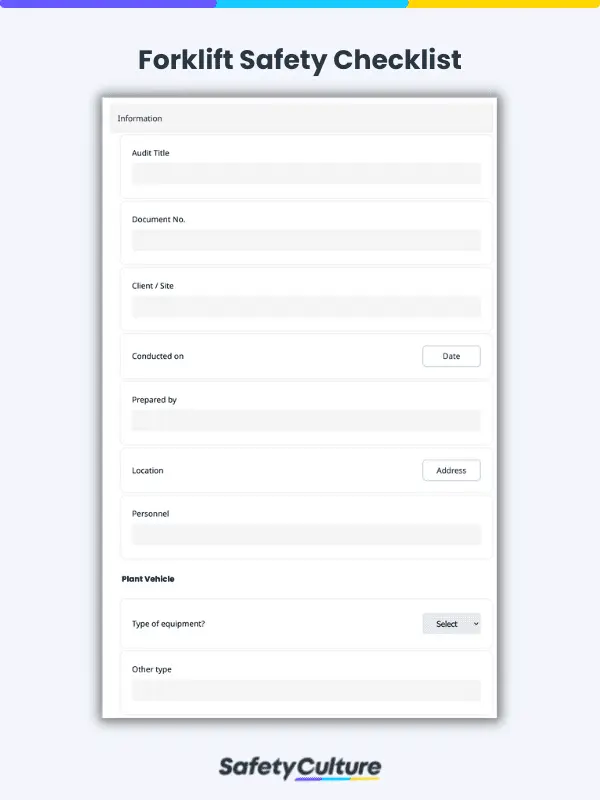What is Forklift Safety?
Forklift safety is the set of procedures utilized for the proper use of forklifts including before and after forklift operations. These forklift safety procedures will minimize the risk of incidents and ensure that the operator and the people within the vicinity are protected.
Forklift Operator Requirements
There are numerous procedures that are in compliance with industry standards such as OSHA’s to ensure forklift safety in the workplace. The most basic operational procedure that was set by OSHA, 1910.178(q)(7), states that industrial trucks such as forklifts should be inspected every day before they’re placed in the service area. Forklifts used round-the-clock should be examined every shift. Defects or signs of wear and tear should be reported immediately. These forklift inspections can be conveniently recorded by using a digital checklist such as these forklift checklists.
Forklift operators are required to participate in and complete training before they’re allowed to operate the forklift. While OSHA doesn’t provide forklift certifications, forklift operators can get training from outside their company and get a certificate for completion of training.
Employers are responsible for certifying that the training provided was adequate and in compliance with OSHA guidelines. The required training content can be found in 1910.178(l)(3). This provision is intended for initial forklift operator training, it also stated to only include topics that are applicable to your work area.
OSHA-powered industrial truck standards recommend that employers give refresher training courses, 1910.178(l)(4), in the following events:
- The forklift operator was using the machine in an unsafe manner
- The forklift operator had been involved in an incident or near-miss accident
- The forklift operator was evaluated to be unsafely operating the equipment
- The forklift operator will be using a different type of forklift or truck
Additionally, OSHA standard 1910.178(l)(4)(iii) states that the employer is required to evaluate the forklift operator every 3 years.
Why Is It Important?
Operating a forklift is not an easy task as driving a regular vehicle. Forklift-related accidents account for 79 fatalities and 8,140 nonfatal work-related injuries in the year 2019 according to the National Security Council. These numbers are less than what it was two decades ago when CDC reported that there were 100 fatalities while 20,000 accounts for nonfatal injuries.
In the years that followed, newer technology emerged and the implementation of safety standards has been better. Statistics show that the number of forklift-related injuries are slowly decreasing every year. There is a potential to reach zero work-related forklift injuries if only employers complied with the safety regulations and forklift operators received proper training and support.
Hazards and How to Keep Employees Safe
OSHA estimates that around 20-25% of forklift related injuries are caused by inadequate training while CDC listed the top 4 types of forklift incidents which are forklift overturns (22%), worker on foot struck by forklift (20%), victim crushed by forklift (16%), fall from forklift (9%). For fatal accidents, 42% is caused by forklifts tipping over (OSHA).
The following table is the complete data for forklift operations fatalities as provided by OSHA:
| Type of Accident | Percentage |
| Crushed by tipping vehicle | 42% |
| Crushed between vehicle and a surface | 25% |
| Crushed between two vehicles | 11% |
| Struck or run over by vehicle | 10% |
| Struck by falling material | 8% |
| Fall from platform on forks | 4% |
| Accidental activation of controls | 2% |
Forklift accidents can cause the company to incur additional operating costs due to the damage on products and property. Additionally, in the event of personnel-related injuries, employers can be responsible for covering hospital, recovery, and other work-related injury expenses.
The best way to prevent forklift incidents is to be aware of the safety hazards and factors present in the work area.
Improve your EHS Management
Cultivate a safe working environment and streamline compliance with our EHS solutions.
Explore nowCommon Factors of Forklift Accidents
Here are the common reasons why forklift accidents may occur in the workplace and the corresponding forklift safety tips:
- Speeding – set a speeding limit while operating a forklift. A supervisor should consistently remind forklift operators to stay on or below the speed limit. A forklift operator has the possibility of preventing major incidents such as running over someone if they maintain the proper speed.
- Moving while the load is elevated – the fork should stay on rest to safely move between destinations while carrying a load. This will allow the operator to have better visibility and control.
- Unaware pedestrians – Remind all employees to stay away from the path for forklifts and to be vigilant of their surroundings. Pedestrians are also in charge of their own safety and shouldn’t rely on vehicle operators when it’s safer and easier for a person to move away. Both Forklift operators and pedestrians can help each other stay safe and create a culture of safety in the workplace.
- Loads that exceed the weight limit – This cannot only cause damage to the forklift but also cause major accidents such as forklift overturns. Predetermine the weight limit per forklift model and have a supervisor double-check the current load.
- Other improper driving methods – Properly trained forklift operators should be knowledgeable on how to turn, back up, and use the brakes. Correct forklift driving techniques should be part of the required refresher training.
Overlooked Aspects of Forklift Accidents
Here are some aspects that are easily overlooked by people in the facility:
- Jumping out of the forklift – There is a high chance of fatality whenever a forklift operator attempts to jump out of the forklift in accidents such as forklift tipping over. To avoid getting crushed by a forklift, supervisors should remind operators to brace themselves and stay in the forklift in case a forklift is tipping over.
- Signage and markers – Similar to road signs, the facility or area a forklift covers should have visible signs on the floor, aisle, and all around. These signs are usually painted on and display the flow of traffic. Some other signs are “stop and look at hazards” for junctions, and labels such as “loading area.”
- Crowded pathway – Facilities should have enough space for a forklift to maneuver on. This space should be big enough for a forklift operator to back out off and change directions. Pedestrians should avoid crossing crowded pathways and take another route.
- Inspection and maintenance of forklifts – As time goes on, wear and tear due to the frequency of using the forklift can occur. Daily inspections are required to help keep forklift operations safe and in compliance with regulations. Supervisors are responsible for ensuring that inspections are conducted by the operator before and after their shifts.
Additionally, here are some basic forklift safety tips and protocols:

Forklift Safety Tips: Dos and Donts | SafetyCulture
Create your own Forklift Safety checklist
Build from scratch or choose from our collection of free, ready-to-download, and customizable templates.
Browse Forklift Safety checklistsTraining
There are 3 parts of forklift training: formal learning, practical application, and evaluation.
Formal Learning
Formal learning is the initial forklift training an aspiring forklift operator will have to take. As stated earlier, OSHA has recommendations on what the courses should contain. There are many available courses and this stage in training could be taken online. Mobile training applications such as SafetyCulture provide completion certificates for all their courses.
Practical Application
This training stage is applying what you have learned from formal learning. Employers are responsible for providing forklift training to their employees. While this stage of forklift training can be taken outside of the organization, only employers can certify their employees. Supervisors need to be knowledgeable, skillful, and experienced because they are responsible for monitoring forklift operators after their certification.
Evaluation
Managers and supervisors are required to evaluate their forklift operators in a timely manner. Evaluations are used to ensure that the forklift operator’s skills and knowledge are up-to-date. These evaluations can show which areas need improvement and to keep the forklift operators, pedestrians, and facility safe from incidents. Furthermore, this stage is done on a continuous basis. Frequent evaluations can uncover repetitive incidents and other issues that could be corrected. To avoid missing an inspection or an evaluation, the facility should use digital checklist tools that can be assigned to specific employees. Here’s an example of an forklift operator safety checklist:
Using SafetyCulture
Forklift operators can conduct the required daily inspections before operating a forklift using SafetyCulture (formerly iAuditor). Supervisors will be able to be notified and see the report right from their own mobile device. Supervisors can also use the digital checklist tool to conduct frequent evaluations. With SafetyCulture you can:
- Complete inspections online or offline
- Specify the location of the facility or work area
- Upload media files such as images to capture evidences, improve visibility, and keep a photographic record for equipment audits
- Schedule and assign inspections or evaluations
- Not worry about storage and security of recordkeeping due to secure cloud storage
- Train employees on proper forklift safety procedures
- Manage forklifts and other assets anytime and anywhere
- Get valuable data insights that could be used to create corrective actions




